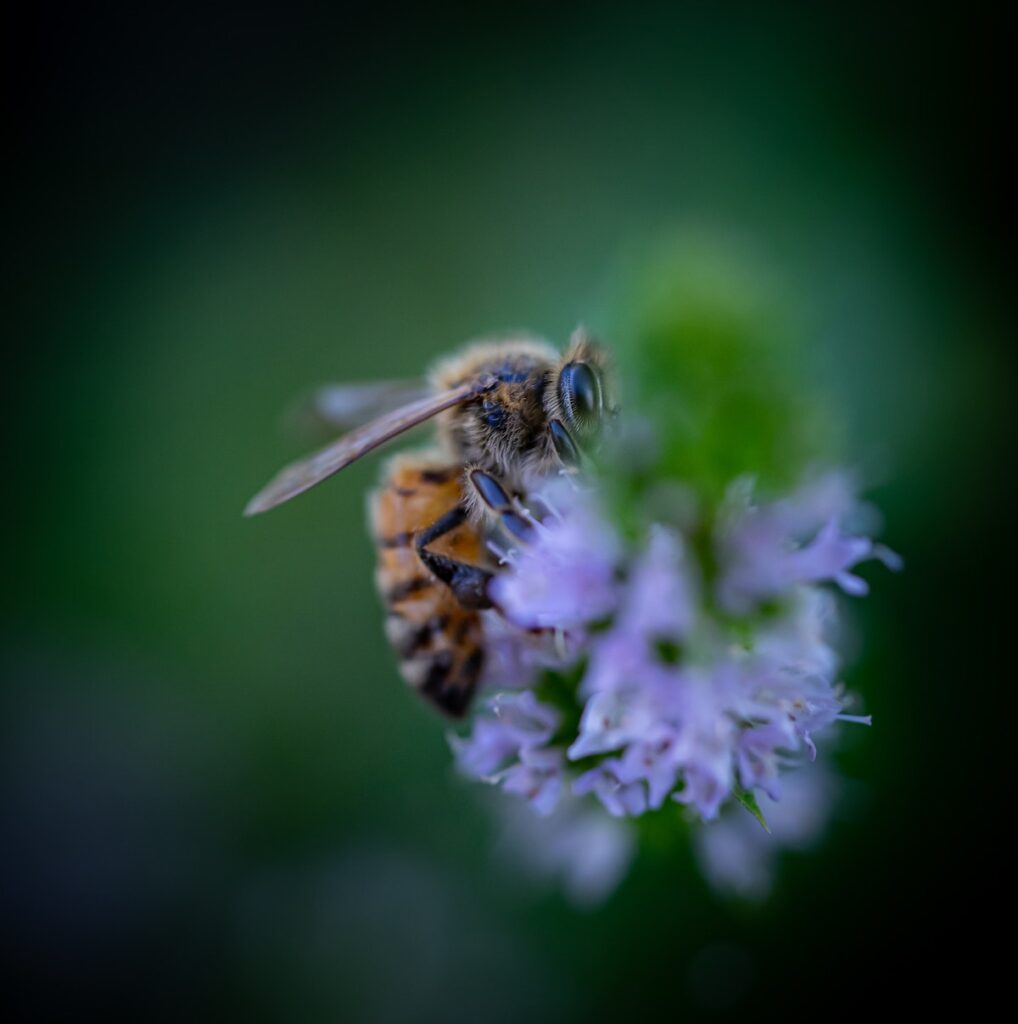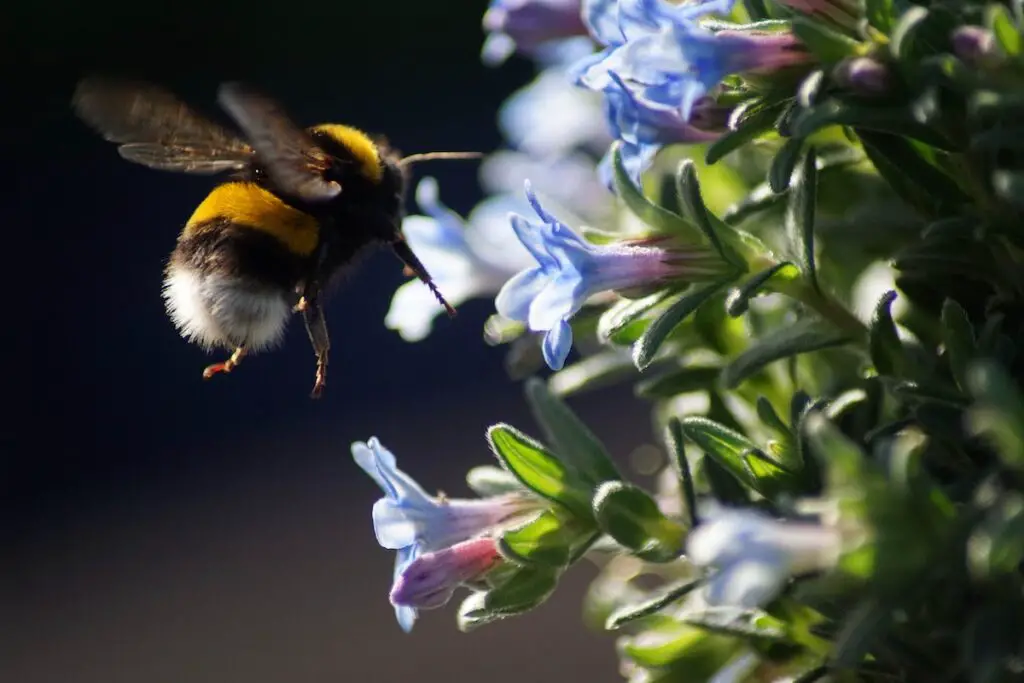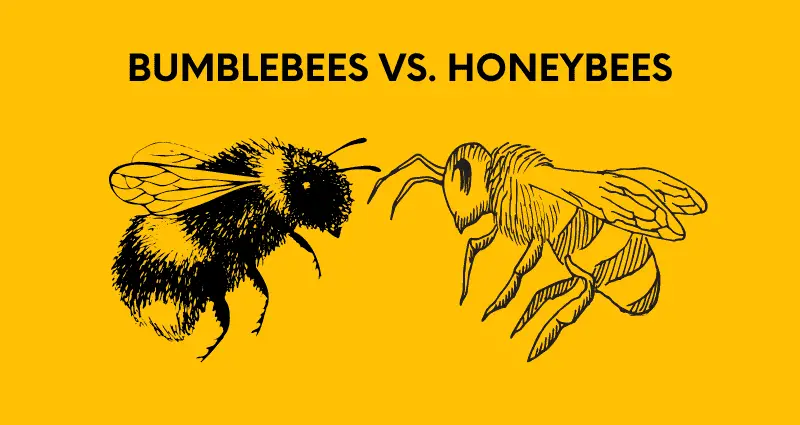The Apoidae superfamily consists of over 5,700 species of bees. The largest individual family within this superfamily is Apidae. The Apidae family contains both bumble bees and honeybees. All bees known as bumble bees, are in the genus Bombus with 250 species worldwide. Honeybees are in the genus Apis, with just 8 surviving species. So, while they are both in the "bee family", they are different in many ways.
Let’s dive into these varying differences below;
Appearance Of Honeybees and Bumblebees
From an entomological perspective, bumblebees and honey bees are very different types of bees.
Those differences are easy to spot immediately though. Start by looking for these three things;
- Fuzz – bumblebees are very hairy, whereas honey bees are not.
- Roundness – Bumblebees are round and orb-like, whereas honey bees are flatter with rounded sides but a flatness to the tops and bottoms of the abdomen.
- Colors – Bumblebees are multicolored with bands or splotches of black, yellow, or even orange-reds. Honey bees are the shade of honey, though some may have a blueish tinge to them.
When it comes to the bumblebee vs. honeybee identification, these three attributes help you quickly tell one from the other.
For more information about honey bee anatomy, click here.
Pictures of honey bees vs. bumblebees
In photographs, it is straightforward to tell a honey bee from a bumblebee. However, the hairy body with the round orb-like structure of the bumblebee is very different from the nearly hairless and flatter body of the honey bee.


How to tell a bumblebee from a honey bee
One way to tell a bumblebee from a honey bee is to check the coloring. Bumblebees are banded with black and yellow, black and orange-red, or mostly black hair.
Honey bees on the other hand are the color of honey.
Aggressive Nature Of Honeybees & Bumblebees
Usually, honey bees and bumblebees are not aggressive. If you compare them with yellowjackets and hornets, honey bees and bumblebees are very docile. That is not to suggest they will not sting you, but they do so with reluctance. There are situations where honey bees may become aggressive. Those include
- Genetics – Africanized honey bees are very aggressive. They are called killer bees, and they will swarm and attack people, pets, and livestock. Someone had the bright idea to cross domestic honey bees with African honey bees, and sadly, the aggressive nature of killer African bees is a dominant genetic trait.
- Queenless bees – Often, the bee colony is angry and short-tempered when the queen dies. In the wild, the hive or colony will replace the queen. In captivity, a beekeeper may replace the queen bee, and the hive will go back to being primarily docile.
- High heat and humidity – both will cause honey bees to become more aggressive., The problem here is that honey is made by dehydrating nectar. When the weather is hot and humid, the nectar does not dehydrate and can spoil.
- Hive & Queen Defense – Both honey bees and bumblebees will defend their hives, mainly if other creatures raid the hive. Bears, badgers, people, and wasps often raid hives.
Bees, wasps, and ants are all in the order hymenopteran, and all use chemical messaging to communicate rudimentary actions to the entire colony. We call it a pheromone, and there are many pheromones that bees use. Aggregation pheromones generally mean they defend or attack, and once one bee releases the aggregation pheromone, the colony responds with the stingers ready. When the danger has passed, the bees release a dispersal pheromone, and the colony goes back to its usual activity.
Do bumblebees sting?
Bumblebees and honeybees will certainly sting, but you have to go out of your way to provoke them. Unlike wasps and hornets, honey bees and bumblebees can only sting once. They will die almost immediately once they’ve stung someone or something.
Plus, male bees cannot sting at all. Only the female bees and wasps can sting.
So, take care to not interrupt an individual bee or colony.
Bumblebee vs. honey bee vs. wasp
Bumblebees, honey bees, and wasps are all cousins. Ants are also a cousin of bees. The females of all hymenopteran species will sting with few exceptions.
A significant difference between wasps and ants vs. bumblebees and honey bees is the ability of wasps and ants to sting repeatedly.
Bumblebees and honey bees will die shortly after stinging once. That is one fact for why wasps and ants are more aggressive than bumblebees and honey bees.
Fun Fact: The top speed of a bumblebee is 30 miles per hour while a honeybee’s top speed is 20 miles per hour.
Lifespan Of Honeybees & Bumblebees
Honey bees live for about six weeks, though some have a lifespan of just a few weeks.
Bumblebees have an equally short life, living for about one month.
The queens of both species live longer. In the case of the bumblebee, a queen may live for a few months to a year. A queen honey bee may live for one to two years.
Bee Social Structure
Honey bees and bumblebees are social insects. Both have a caste system, which means that bees are born into their specific roles. The queen is the only bee who will reproduce, and there is only one queen at a time. All other bees are workers or drones.
Drone bees are males. Worker bees are female, and they toil tirelessly to forage for nectar and pollen for the hive. They also care for younger bees, the queen, the queen’s eggs, and the developing larvae.
It is the caste system that makes life in a honey bee hive possible. Bees work according to their role or caste, which ensures consistent honey production.
Do Bumblebees Make Honey?
Yes, bumblebees make honey.
But, they do not make enough honey to be worthy of beekeeping, but bumblebees, like honey bees, are still an asset to our local and global ecosystems. A colony of bumblebees ranges from 50-500 bees, which is not enough bees to produce enough honey to collect.
Honeybees, on the other hand, have hives full of thousands of bees, making them better pollinators. At the peak of flowering plant season, a honey bee colony may have tens of thousands or more bees.
On average, honeybee colonies will produce around 5.4 gallons of honey per year.
What do bumblebees do?
Before the explorers landed here in what is the modern US, there were no honey bees here. Instead, honey bees are an import from Europe. The native species of bumblebees to the US, along with many other types of native bees, are excellent at pollinating crops.
Do bumble bees live in hives?
Bumblebees do live in hives. However, they prefer to take over the abandoned nesting sites rodents make, and their hives are almost always underground. For that reason, their hives have a relatively mild temperature in summer and remain warm over winter.
Bumblebee Nests
Wild bees and bumblebees nest in the ground, often using fallen hollow trees. They create a hive for the colony to raise young, produce honey, and find shelter from predators and weather.
Click here to learn more about domesticated and wild bee habitats.
Are honey bees more important than bumblebees?
No, not really. Similar to the importance of a diverse plant population, the diversity of species of bees is important for the survival and growth of our ecosystems.
We certainly like to value honeybees due to their robust honey outputs, but we should never forget how bumblebees and the hundreds of other wild bee species help maintain our way of life.
Ready for more? Click here to read about the differences between Queen Bees & Worker Bees

